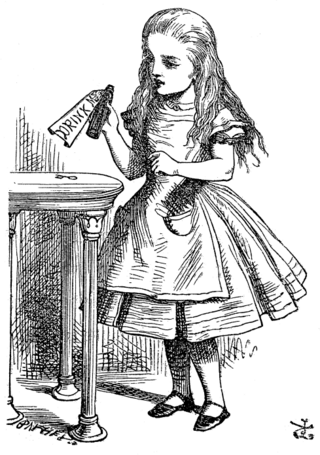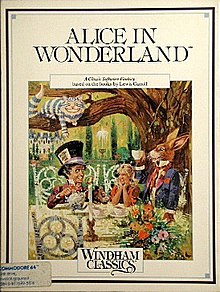
Through the Looking-Glass, and What Alice Found There is a novel published on 27 December 1871 by Lewis Carroll, a mathematics lecturer at Christ Church, University of Oxford, and the sequel to Alice's Adventures in Wonderland (1865). Alice again enters a fantastical world, this time by climbing through a mirror into the world that she can see beyond it. There she finds that, just like a reflection, everything is reversed, including logic.

Alice's Adventures in Wonderland is an 1865 English children's novel by Lewis Carroll, a mathematics don at Oxford University. It details the story of a young girl named Alice who falls through a rabbit hole into a fantasy world of anthropomorphic creatures. It is seen as an example of the literary nonsense genre. The artist John Tenniel provided 42 wood-engraved illustrations for the book.
Alice in Wonderland may refer to:

Alice is a fictional character and the main protagonist of Lewis Carroll's children's novel Alice's Adventures in Wonderland (1865) and its sequel, Through the Looking-Glass (1871). A child in the mid-Victorian era, Alice unintentionally goes on an underground adventure after falling down a rabbit hole into Wonderland; in the sequel, she steps through a mirror into an alternative world.

Underwurlde is a 1984 action-adventure platform video game in the Sabreman series by Ultimate Play the Game for the ZX Spectrum and Commodore 64. The player controls the adventurer Sabreman as he jumps between platforms in a castle and its caverns to find an escape past the exit guardians. Underwurlde features about 600 flip screen areas. Unlike other games of its time, Sabreman is not injured when touched by enemies and is instead knocked backwards. Underwurlde is the second game in the series, between Sabre Wulf and Knight Lore, and released shortly before the latter for the ZX Spectrum in late 1984. Another developer, Firebird, ported the game to the Commodore 64 the next year.

The Caterpillar is a fictional character appearing in Lewis Carroll's 1865 book Alice's Adventures in Wonderland.

Questprobe: Featuring Spider-Man is the second video game in the Questprobe series.

Spinnaker Software Corporation was a software company founded in 1982 known primarily for its line of non-curriculum based educational software, which was a major seller during the 1980s. It was founded by chairman Bill Bowman and president C. David Seuss.

Lewis Carroll's books Alice's Adventures in Wonderland (1865) and Through the Looking-Glass (1871) have been highly popular in their original forms, and have served as the basis for many subsequent works since they were published. They have been adapted directly into other media, their characters and situations have been appropriated into other works, and these elements have been referenced innumerable times as familiar elements of shared culture. Simple references to the two books are too numerous to list; this list of works based on Alice in Wonderland focuses on works based specifically and substantially on Carroll's two books about the character of Alice.

Pirate Adventure is a text adventure program written by Scott Adams.

The Wonderful Wizard of Oz is a 1900 children's novel written by American author L. Frank Baum. Since its first publication in 1900, it has been adapted many times by L. Frank Baum and others: for film, television, theatre, books, comics, games, and other media.

Wonderland is an interactive fiction game developed by Magnetic Scrolls and published in 1990 by Virgin Games.

The Red Queen is a fictional character and the main antagonist in Lewis Carroll's fantasy 1871 novel Through the Looking-Glass. She is often confused with the Queen of Hearts from the previous book Alice's Adventures in Wonderland (1865), although the two are very different.
Windham Classics Corporation was a subsidiary of Spinnaker Software. The corporation was founded in 1984 and went defunct circa 1985/86 or later. The headquarters were in Cambridge, Massachusetts, USA.

Through the Looking Glass, also known as Alice, was a 1984 video game written for the Apple Lisa and Apple Macintosh computers. Written by a member of the Lisa and Mac teams, Steve Capps, it was one of the earliest video games on the Mac platform, part of the only games disk officially sold by Apple Computer during that era.
Voyager was a graphic adventure computer game developed by Looking Glass Technologies from 1995 until its cancellation in 1997. It was published by Viacom New Media. Based on the Star Trek: Voyager license, the game followed Kathryn Janeway and the crew of the USS Voyager in their attempts to rescue members of their team from the Kazon. Voyager was the first game in a multi-title agreement between Viacom and Looking Glass, and Viacom took a minority equity investment in the company as part of the deal. However, Viacom decided to leave the video game industry in 1997, and Voyager was cancelled in spring of that year. In response to Voyager's cancellation, team members Ken Levine, Jonathan Chey and Rob Fermier left Looking Glass to found Irrational Games.

Alice, the main protagonist of Lewis Carroll's novels Alice's Adventures in Wonderland (1865) and Through the Looking-Glass (1871), has been adapted to several media.

Alice in Wonderland, or simply Alice, is a Disney media franchise, commencing in 1951 with the theatrical release of the animated film Alice in Wonderland. The film is an adaptation of the books by Lewis Carroll, the 1865 novel Alice's Adventures in Wonderland and its 1871 sequel Through the Looking-Glass, which featured his character Alice. A live-action film directed by Tim Burton was released in 2010.

The Thompson Twins Adventure is a 1984 graphic adventure game that was distributed by Computer and Video Games magazine as a promotional 7" flexi disc "freebie" along with its October 1984 issue. The game is based on the Thompson Twins' single "Doctor! Doctor!", and features the Thompson Twins band members as the protagonists. The unusual storage format of the game showcases an experimental technique pioneered by the London-based Flexi Records label, and places the game alongside a small handful of other games distributed on grooved disks. This format never became established and The Thompson Twins Adventure is today valued more for its nostalgic and artifactual value than for its ludological aspects which have been uniformly panned by critics.

The Wizard of Oz is an illustrated interactive fiction game developed by and published by Windham Classics for the Apple II, Commodore 64, MS-DOS and MSX in 1985. It is an adaptation of the books The Wonderful Wizard of Oz and The Marvelous Land of Oz.
















